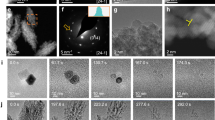Abstract
The dissolution of brucke, Mg(OH)2, on the (001) surface was investigated using in situ atomic force microscopy in solutions at near-neutral pH. Dissolution proceeded by the formation of crystallographically oriented triangular etch pits with monolayer step and expansion of the pits. The sides of the triangle are parallel to the [100], [110] and [010] directions of the brucite structure, and the orientation of lines from the center of the triangle to the three apices are along the [210], [\([\bar 110]\)] and [\([\bar 1\bar 20]\)] directions. This orientation may produce pit edges where OH groups coordinate to two Mg2+. Although triangular etch pits with monolayer depth formed mostly at random on the (001) surface, concentric pits penetrating several layers were also observed. Etch pits with spiral steps were rarely observed. Coalescence of the pits resulted in stranded terraces that diminished in size rapidly and formed a rounded irregular form. The step-retreat velocity around the triangular pit is 0.015–0.04 nm/s at pH 5–8. The retreat velocity around the stranded terraces was about three times more rapid than that around the triangular etch pits.
Similar content being viewed by others
References
Arvidson, R.S., Ertan, I.E., Amonette, J.E. and Luttge, A. (2003) Variation in calcite dissolution rates: A fundamental problem? Geochimica et Cosmochimica Acta, 67, 1623–1634.
Binning, G., Quate, C.F. and Gerber, Ch. (1986) Atomic Force Microscope. Physical Review Letters, 56, 930–933.
Bosbach, D. and Rammensee, W. (1994) In situ investigation of growth and dissolution on the (010) surface of sypsum by Scanning Force Microscopy. Geochimica et Cosmochimica Acta, 58, 843–849.
Dove, P.M. and Platt, F.M. (1996) Compatible real-time rates of mineral dissolution by Atomic Force microscopy (AFM). Chemical Geology, 127, 331–338.
Heaton, J.S. and Engstrom, R.C. (1994) In situ atomic force microscopy study of the differential dissolution of fayalite and magnetite. Environmental Science and Technology, 28, 1747–1754.
Jordan, G. and Rammensee, W. (1996) Dissolution rates and activation energy for dissolution of brucite (001): A new method based on the microtopography of crystal surfaces. Geochimica et Cosmochimica Acta, 60, 5055–5062.
Jordan, G., Higgins, S.R. and Eggleston, C.M. (1999) Dissolution of the periclase (001) surface: A scanning force microscope study. American Mineralogist, 84, 144–151.
Kogure, T. (2002) Identification of polytypic groups in hydrous phyllosilicates using electron back-scattering patterns. American Mineralogist, 87, 1678–1685.
Lasaga, A.C. and Luttge, A. (2003) A model for crystal dissolution. European Journal of Mineralogy, 15, 603–615.
Peskleway, C.D., Henderson, G.S. and Wicks, F.J. (2003) Dissolution of gibbsite: Direct observations using fluid cell atomic force microscopy. American Mineralogist, 88, 18–26.
Pokrovsky, O.S. and Schott, J. (2004) Experimental study of brucite dissolution and precipitation in aqueous solutions: Surface speciation and chemical affinity control. Geochimica et Cosmochimica Acta, 68, 31–45.
Pokrovsky, O.S., Schott, J. and Castillo, A. (2005) Kinetics of brucite dissolution at 25°C in the presence of organic and inorganic ligands and divalent metals. Geochimica et Cosmochimica Acta, 69, 905–918.
Rufe, E. and Hochella, M.F. (1999) Quantitative assessment of reactive surface area of phlogopite during acid dissolution. Science, 285, 874–876.
Shiraki, R., Rock, P. and Casey, W.H. (2000) Dissolution kinetics of calcite in 0.1 M NaCl solution at room temperature: An atomic force microscope (AFM) study. Aquatic Geochemistry, 6, 87–108.
Vermilyea, D.A. (1969) The dissolution of MgO and Mg(OH)2 in aqueous solutions. Journal of Electrochemical Society, 116, 1179–1183.
White, A.F. and Brantley, S.L. (1995) Chemical Weathering Rates of Silicate Minerals. Mineralogical Society of America, Washington, D.C.
Author information
Authors and Affiliations
Corresponding author
Rights and permissions
About this article
Cite this article
Kudoh, Y., Kameda, J. & Kogure, T. Dissolution of brucite on the (001) surface at neutral pH: in situ atomic force microscopy observations. Clays Clay Miner. 54, 598–604 (2006). https://doi.org/10.1346/CCMN.2006.0540506
Received:
Revised:
Published:
Issue Date:
DOI: https://doi.org/10.1346/CCMN.2006.0540506



